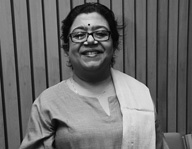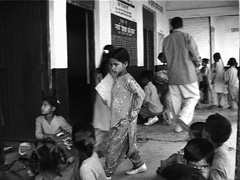Juror
Gargi Sen
 [Juror’s Statement]
[Juror’s Statement]
I have often felt that documentary is like the antagonist on a stage, versus fiction, the protagonist. The antagonist can be anyone or anything; the empty space, a light beam, a flower, or indeed an actor. It flows and eddies freely, open to interpretation, present in the moment. But as cinema is not drama, this analogy can go only so far. Nevertheless, within the realm of cinema, the documentary practice is truly a search for freedom, experimentation and expression. This is particularly true in Asia.
In India, despite the most difficult circumstances, the independent documentary has carved out a space for itself—a special niche that is both visible and invisible. With very little funding and even less distribution, documentary practitioners have taken on the onus of producing, directing, distributing and exhibiting their films. And by doing so, they have created spaces for interaction, interpretation and inspiration. A growing audience is engaging with this art form in informal places like cultural centres, and film festivals and screenings are held in academic and other kinds of spaces. Simultaneously, the number of practitioners is also growing, as is the number of very significant films.
However, the space that is carved out is also invisible to the public in general. Perhaps that is the nature of the practice. Or maybe because it’s not a mass medium but caters to a niche, engaged audience. Or possibly its lack of access to mass exposure on television or in wide theatrical release makes it invisible. Be that as it may, documentary in India straddles a space both visible and invisible at the same time.
The nature of this duality might also be the strength of the practice of documentary. After all, this is what affords it its freedom. Therefore connections are made rather invisibly, but with tensile strength, leading to unknown and unexpected outcomes.
And I feel the task today is to spread these rather tenuous, almost invisible, and yet strong links across borders and cultures so that these very significant documentaries can circulate. Circulation of culture today needs a fresh perspective, a new philosophical approach that combines technology and enterprise with works of art to create routes to circulate that are different from traditional routes of commerce or capitalism.
Gargi Sen is a director, curator, distributor, exhibitor, and producer of cinema. She studied Visual Communication at the National Institute of Design, graduating in 1986. She co-founded the Magic Lantern Foundation (now Magic Lantern Movies LLP) in 1989. Through archiving and dissemination of independent documentaries, it aims to support independent documentary practice in the region. In 2002, she got her MA in Mass Communication from the University of Leicester, and in 2008 she created Persistence Resistance, a film festival that presents multiple screening and viewing practices. In 2012, she initiated DocWok, a documentary mentoring program in partnership with DOK Leipzig.
 A School of My Own
A School of My Own
- INDIA / 2009 / Hindi, English / Color /Blu-ray / 33 min
Director, Script: Gargi Sen
Photography: R.V. Ramani
Editing: Sameera Jain
Sound: Asheesh Pandya
Production: Film and Television Institute of India
Source: Magic Lantern Foundation
 Beyond Monarchs and Merchants
Beyond Monarchs and Merchants
- INDIA / 2002 / Hindi, English / Color / Blu-ray / 56 min
Director, Script: Gargi Sen
Photography: R.V. Ramani
Editing: Ranjan De
Sound: Vipin Bhati
Sound Design: Asheesh Pandya
Production: The Public Service Broadcasting Trust
Source: Magic Lantern Foundation
A School of My Own captures what school means to children living at the base of the Himalayas, and their parents, who want them to be educated; in an intimate look at their daily lives. In Beyond Monarchs and Merchants, a frog is our guide, as the film probes a variety of people humorously and earnestly on their feelings about a daily life that has become inseparable from television culture. Both films were filmed by R.V. Ramani, director of Nee Engey—Where Are You (2003, YIDFF 2003 New Asian Currents).
